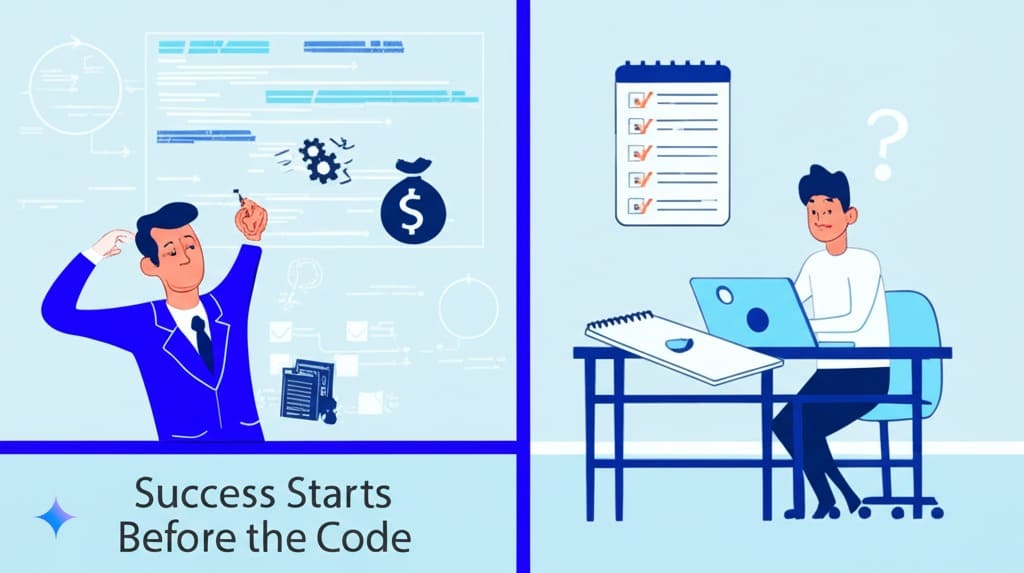
I’ve watched countless technical founders pour their hearts, souls, and considerable genius into startups that never gained traction.
After guiding dozens of technical startups through my agency, some to successful exits, I’ve noticed a pattern.
The determining factor in success rarely hinges on technical brilliance alone.
Key takeaways:
- Most technical startups fail due to insufficient problem validation, not technical shortcomings
- People buy solutions to painful, expensive problems—not cool technology
- Your first target audience should be ridiculously specific, not broad
Beyond the Hype – Real-World Insights from the Startup Trenches
My technical agency has worked with founders across industries—from fintech to healthcare to marketing tools.
We focus on technical strategy, product development, and scalable engineering practices.
Through these experiences, one truth stands out: rigorous problem validation is the non-negotiable first step.
Everything else—your elegant code, your revolutionary architecture, your cutting-edge AI model—becomes irrelevant without it.
Let me share what we’ve learned the hard way.
The Foundational Principles: Why People Actually Buy Technical Solutions
Many technical founders fall in love with their solutions before confirming anyone cares about the problem.
Great tech doesn’t automatically equal success.
Our agency has observed five foundational truths about why customers purchase technical products:
- Solving Painful, Expensive Problems: People reach for their wallets when facing significant pain
- Creating Significant New Value: Solutions that unlock previously unavailable opportunities drive adoption
- Removing Friction from Existing Workflows: Making tedious processes effortless creates loyal customers
- Providing Unique Insights/Data: Exclusive information or analysis delivers competitive advantage
- Scaling Manual Processes: Automation of repetitive tasks frees up valuable human resources
The most successful technical startups nail at least three of these principles. Industry leaders hit all five.
Stripe: A Prime Example of All Five Principles
Stripe exemplifies these principles perfectly:
| Principle | How Stripe Delivers |
|---|---|
| Solving Pain | Simplified formerly complex payment processing |
| Creating Value | Enabled seamless international transactions |
| Removing Friction | Provided dead-simple API integration |
| Unique Insights | Offered dashboard analytics and fraud detection |
| Scaling Processes | Automated payment processing at any scale |
According to a 2023 McKinsey study, companies that focus on solving genuine customer pain points are 3.5 times more likely to achieve sustainable growth compared to those focusing primarily on technological innovation.
This framework applies universally across SaaS, platforms, hardware/software hybrids, AI/ML products, and infrastructure solutions.
The Crucial First Step: Problem Validation – Does Anyone Care Enough to Pay?
Before writing a single line of code, validating your problem should be your absolute priority.
Your early-stage activities should focus on answering these three critical questions:
- Pain Point Intensity: Is the problem significant enough that people are actively seeking solutions? You need a resounding “YES”
- Existing Investment: Are people currently spending money or significant time trying to solve this problem? Again, you need a “YES”
- 10x Improvement Potential: Can your solution offer a dramatically better alternative to current approaches? This must be a “YES”
Missing any of these means you’re building something nobody wants.
The Cloud Optimization Algorithm: A Cautionary Tale
My agency once worked with a brilliant team of engineers who developed an impressive cloud optimization algorithm.
Their solution could reduce AWS costs by 15-20% without performance impact. On paper, it looked like a winner.
After six months of development, they struggled to find buyers.
Why?
During customer interviews, we discovered a fundamental disconnect:
- Infrastructure managers cared more about reliability and performance than cost optimization
- The 15-20% savings weren’t significant enough to justify switching costs
- Decision-makers were rewarded for uptime, not cost savings
Despite technical excellence, the solution solved a “nice-to-have” problem rather than a “must-have.”
The founders had failed to validate the problem before building.
Harvard Business School research shows that 42% of startups fail because they build products nobody wants.
The power of pain matters—solving problems that “keep people up at night” leads to willingness to pay.
The Four Pillars of Rigorous Problem Validation
Based on our experience guiding technical startups, we’ve identified four essential pillars of effective problem validation:
A. Industry Expertise: Knowing the Domain Inside and Out
Deep domain knowledge is non-negotiable. Ask yourself: Could you deliver a compelling talk at an industry conference about the problem you’re solving?
For those lacking domain expertise, you have two options:
- Partner with industry experts (advisors, co-founders)
- Gain experience through immersion (work in the field)
Building in unfamiliar territory dramatically increases your risk of failure.
Common failures we’ve seen due to lack of domain understanding include:
- Healthcare startups underestimating HIPAA compliance complexity
- Fintech products ignoring regulatory requirements
- Marketing tools misunderstanding workflow integration needs
Technical advisors can help, but they’re worthless if you ignore their feedback. My agency has accurately predicted numerous startup failures when founders dismissed expert advice.
B. Technical Landscape Research: Understanding the Existing Ecosystem
Comprehensive research goes beyond direct competitors. You need to understand:
- How customers currently solve the problem (commercial tools, open-source options, DIY solutions, manual processes, spreadsheets, adjacent tools)
- The broader technical ecosystem surrounding your solution
- Integration opportunities with existing tools
- Potential users and their tech environments
- Pain points with existing solutions
- Regulatory and compliance requirements
Digital products face low barriers to entry, making competition inevitable. Smart founders embrace this reality.
Research should span:
- GitHub (open source projects, issues)
- Stack Overflow (developer questions)
- Reddit and HackerNews (community discussions)
- Review sites (G2, Capterra)
- Industry forums
- LinkedIn groups
Focus on understanding sentiment—what users love and hate about existing options, feature engagement, and common complaints.
A 2022 CB Insights study found that startups that conducted comprehensive competitor analysis were 33% more likely to secure funding beyond Series A.
Identify opportunities by correlating technical limitations with user complaints.
This gap analysis often reveals the most promising avenues for innovation.
C. Audience Specificity: The Power of Narrow Focus
The “build for everyone” approach fails consistently. Define a narrow, well-defined initial target audience.
Your ideal first customer:
- Feels the problem acutely
- Has budget authority
- Makes decisions quickly
- Can implement your solution easily
- Will provide meaningful feedback
You need to be ridiculously specific. Consider this progression for a cloud security tool:
- Companies using cloud infrastructure (too broad)
- Companies using AWS (still too broad)
- Mid-sized SaaS companies using AWS (getting closer)
- Mid-sized fintech SaaS companies using AWS (better)
- Mid-sized fintech SaaS companies using AWS with compliance requirements and 50-200 employees (perfect)
Audience specificity delivers tremendous advantages:
- Solutions precisely tailored to real needs
- Features that feel like “magic” to users
- More effective marketing and sales messaging
A Stanford study found that startups with highly specific initial target markets achieved product-market fit 2.3 times faster than those with broad targets.
Your solution should seamlessly integrate with existing tools used by your target audience.
This reduces friction and accelerates adoption.
D. Budget Confirmation: Understanding the Economic Landscape
Your solution must save or make enough money to justify its cost.
This directly impacts pricing and growth potential.
Examples of value-based pricing include:
- 10% of cost savings delivered
- 20x the hourly rate saved
- 5% of additional revenue generated
Key budget questions to answer:
- What’s the current cost of the problem?
- Who controls the relevant budget?
- What’s the typical purchasing process?
- Is spending in this category growing or shrinking?
According to Gartner research, solutions impacting revenue or core operations command higher prices and face less procurement friction.
A technical product that directly impacts top-line growth can charge 3-5x more than one focused on cost reduction.
A Glimpse into Building the Solution: Engineering Culture and Priorities
Once you’ve thoroughly validated your problem, your engineering approach should prioritize:
Clarity Over Cleverness: Maintainable code trumps elegant solutions. Follow the “5-minute understanding” rule—new team members should grasp your core architecture within five minutes.
The “Why” of Technical Decisions: Document not just what you built, but why you built it that way. Future decisions depend on understanding past reasoning.
Architecture Decision Records (ADRs): Formalize your technical choices with brief documents explaining:
- Context and problem
- Decision
- Alternatives considered
- Consequences and trade-offs
Strategic Tech Stack Selection: Choose proven, stable technologies with strong community support rather than cutting-edge options that may not persist.
Your early-stage priorities should follow this sequence:
- Problem validation
- Technical architecture
- MVP scope
- Go-to-market strategy
Final Thoughts
Thorough problem validation forms the bedrock of successful technical startups.
My agency has seen brilliant technical solutions fail due to insufficient validation, while seemingly simple products flourished because they solved real, painful problems.
The unsexy truth remains: technical success starts before the code.
Master the four pillars of problem validation:
- Deep industry expertise
- Comprehensive technical landscape research
- Specific audience definition
- Clear budget confirmation
These foundations will dramatically increase your chances of building something people actually want and will pay for.
What painful problem are you solving? Have you validated it thoroughly? Share your experiences in the comments below.






